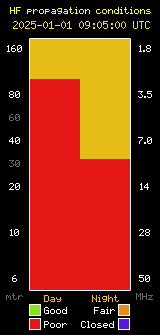 If you want to have a bit of fun and try out some superb new beta software, then get this app installed on your smartphone, and meet me on GB3HY after one of the Wednesday night nets for a little testing and larking about.
If you want to have a bit of fun and try out some superb new beta software, then get this app installed on your smartphone, and meet me on GB3HY after one of the Wednesday night nets for a little testing and larking about.
The app you need is called Rattlegram, and it's available on Google Play, but is sadly not yet available on iOS.
It's based on COFDM (coded orthogonal frequency-division multiplexing) technology with the following specifications:
- 160 ms long OFDM symbols
- 6.25 Hz per sub-carrier
- 1/8 guard interval
- differentially encoded PSK (phase-shift keying) modulation
- systematic polar codes for forward error correction
...and it works purely on audio files!
You type some text, the app does the OFDM encoding and DAC and then spits the resulting noise out of the speaker. The encoding uses something called an Inverse Fourier Transform, which is way above my level of comprehension.
The sound is then received by the same app on another phone (in 'listening' mode) and then ADC'd and decoded back into text. That may not sound so new, but the technology is (relatively) and especially in terms of amateur radio. In fact it uses basically the same protocol as WiFi, 4G and 5G, so data rates can theoretically get pretty high if you can keep the noise levels down.
Each of the 256 sub-carriers is - yes you read that correctly - just 6.25Hz wide, and to deal with reflected signals, each data packet has a 1/8 guard interval. That equates to a total 180 ms symbol duration including a 20 ms pause between symbols to avoid data 'collisions', but it also includes FEC to add a whopping 50% redundancy and therefore dramatically reduces transmission errors. This is important as there isn't any possibility of re-transmission. FEC works in the same way as for unidirectional digital satellite, cable and terrestrial television transmissions and Rattlegram employs QPSK (Quadrature Phase Shift Keying) modulation.
In testing, I've had this working with good reliability. I started with phone-phone, then tried it with a radio link in the middle on 146.9125MHz, and then I even tried it on GB3HY - receiving on both the input and output frequencies using an Icom and an SDR on a laptop on opposite sides of the house.
If I get a chance, I'll be trying it out on the HF bands tomorrow using the clubs' Flex radio, though I expect the error rates will increase.
This is the easiest 'data mode' technology I've seen that has usable performance. What could be simpler than holding your phone up to your radio?
Data over RF for the smartphone generation. Everybody wins... and this could easily be turned into a PC-based utility cabled directly to a radio to increase throughput.
Enjoy your radio!
Berni M0XYF



